Article and photos by Joe Sapia
Note: The yard references are to my house in the section of Monroe between Helmetta and Jamesburg in South Middlesex County. My yard is in a Pine Barrens outlier on the Inner Coastal Plain, the soil is loamy, and my neighborhood is on the boundary of Gardening Zones 6b (cooler) and 7a (warmer). Afield references are to the Pine Barrens around Helmetta, unless otherwise noted. Notes and photographs are for the period covered, unless otherwise noted.
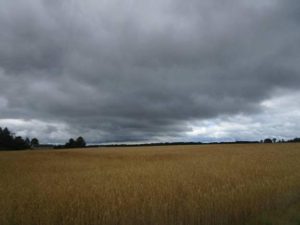
A rainy day begins to clear at a farm on Plainsboro Road in Cranbury, Middlesex County.
IN THE GARDEN: Harvesting-wise, the garden has slowed down, with the lettuce taking on a bitter taste, suggesting it is done for the cool season. I will plant more lettuce later in the summer for the fall season. Otherwise, I wait for tomatoes, corn, and cantaloupe. I do not know what happened to my cucumbers, except that I cannot find any growing. So, again, it is the three Ws: Water, Weed, and Wait. But the big discovery, or re-discovery, was the tomatillo plants growing, and fruiting, in the garden. I never planted them, but, for at least three gardening seasons, there they are. So, add them to my future harvest.
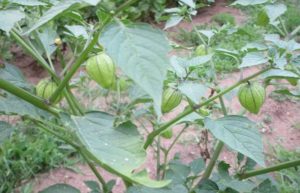
Tomatillos, which I never planted, fruiting in the garden.
AROUND THE YARD: I try to observe, whether it be looking around the yard or the sky (both night and day). As the week wrapped up and I was in the garden, I saw a red-tailed hawk, “Buteo jamaicensis,” soaring over the neighborhood. The Knock Out roses continue blooming nicely, the second bloom of the season. And I am visited by rabbits, probably “Sylvilagus floridanus,” and one of my favorites in wildlife, the catbird, “Dumetella carolinensis.” A catbird, unsure if it is the same one, keeps me company in the yard, whether I am gardening or simply hanging out.

A red-tailed hawk soaring over the neighborhood.
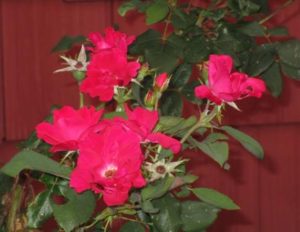
The yard’s Knock Out roses are in their second bloom of the season.
PINE BARRENS AROUND HELMETTA: Over the week, I walked afield only once and briefly. But I am around the wilds and drive paved roads through them daily. And I keep the camera at hand. I photograph a lot in a capture-the-moment way. So, I avoid using a cellphone, because it takes too long to unlock and it is too difficult to maneuver one-handed, instead using a point-and-shoot camera. I keep the camera at the ready — on the dashboard of my Jeep or, when I am doing yard work, in my pocket. Alas, this week, I was driving, I could not stop the Jeep, grab the camera, and focus the camera quickly and properly, missing a good photo of a group of turkeys, “Meleagris gallopavo,” with a deer, “Odocoileus virginianus,” in the background, around a woodpile as I drove past a house in the woods of Jamesburg Park. But I did photograph the turkeys and deer separately.
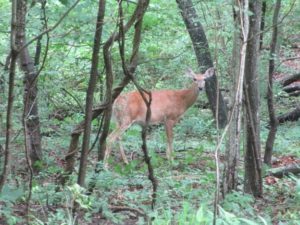
The deer in the Jamesburg Park section of East Brunswick.
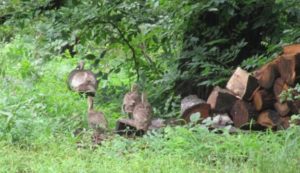
The Jamesburg Park turkeys.
WATERING THE GARDEN: I continue to obsess over watering the garden. This year, I have avoided “brown water,” or already used water such as bath water. Instead, I use freshwater, a combination of house system water, water from Manalapan Brook, captured rain water, and water from the cellar de-humidifier. I water daily, always before 10 a.m. so water is not lost to evaporation in the heat of the day and leaving the day for the plants and soil to dry, keeping fungus away. Now, I am considering watering fewer times a week, but in heavier doses. Friend, gardener, and environmental scientist Virginia Lamb had these thoughts, “I only water maybe twice a week and directly on plants, individual or rows. Probably roughly 2 quarts per plant. … Also you need to add mulching to your list of three Ws. …It will help retain moisture and keep weeds down. Also, add compost to the soil.”
EBONY JEWELWING AT THE BROOK: Manalapan Brook, which my family through my maternal side has lived along more than 100 years, runs about 400 feet from my front door. I regularly take a walk across the street and head to the Brook at the edge of the woods. This week, I encountered one of my favorite wildlife species, the ebony jewelwing damselfly, “Calopteryx maculate” – a beautiful combination of neon green and deep black. Two were flying around. I was hoping at least one would land on my outstretched arm, but not on this day. Eventually, I grabbed a bucket of water for my garden and went back home.
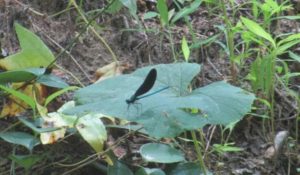
An ebony jewelwing rests along the bank of Manalapan Brook.
DAMSELFLY OR DRAGONFLY: When I was visiting Manalapan Brook, I also saw a dragonfly. What kind? I do not know. But I knew it was a dragonfly because at rest, its wings were like those of an airplane, parallel to the ground. A damselfly rests with its wings perpendicular to the ground.
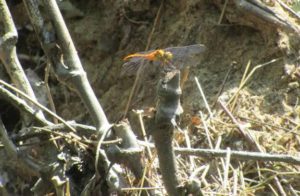
A dragonfly on the bank of Manalapan Brook.
SPOTSWOOD LAKE: Spotswood Lake, also known as DeVoe Lake or Mill Lake, is formed by the damming of Manalapan Brook. I happened to be at Spotswood Lake this week when the moon rose above it early in the night. So, there was a nice combination of the moon and soft sunlight.

The moon over Spotswood Lake.
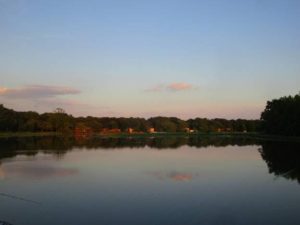
Soft sunlight on Spotswood Lake.
BALD EAGLES: I saw a Facebook report of a bald eagle, “Haliaeetus leucocephalus,” on road kill in Jamesburg. Debbie Sullivan Farrell reported, “Did anyone else see the eagle by the rescue squad at 9:50 this morning? I turned onto Gatzmer from Hillside and was going towards the tracks. An eagle was checking out some road kill and flew off towards the firehouse. It was huge!!! Then I saw the unmistakable white head. It was about 20 feet from me. It was an amazing sight.” The state Department of Environmental Protection 2016 bald eagle nest summary, http://www.conservewildlifenj.org/downloads/cwnj_736.pdf. Bald eagles are “endangered” (in immediate peril) as breeders and “threatened” (could become endangered if conditions persist) as non-breeders. In 1982, there was only one bald eagle nest in New Jersey; Last year, there were about 150.
GROVERS MILL: Does the name of this village in West Windsor, Mercer County, sound familiar. Well, it was the site of the Martian landing in the 1938 radio play adaptation -– by Orson Welles and the Mercury Theatre on the Air — of H.G. Wells’s novel, “The War of the Worlds.” Here is the broadcast that scared the country, https://www.youtube.com/watch?v=Xs0K4ApWl4g. Here is the story of the “panic broadcast,” http://www.smithsonianmag.com/history/infamous-war-worlds-radio-broadcast-was-magnificent-fluke-180955180/.
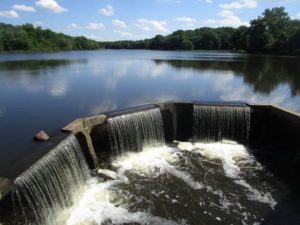
A view of Grovers Mill Pond from the spillway. The Pond is formed by the damming of Bear Brook.
RECORD GARDEN THOUGHTS: As I work the garden, I have thoughts on how I can improve it in 2018. I likely will not simply remember these ideas, so I am writing them down – things such as rotating crops, keeping only a lawnmower’s width between rows, maybe doing less space between plantings, and so on.
“FALL FOLIAGE” IN THE PINE BARRENS: Summer lovers, you probably do not want to hear about colder weather coming. But those of you venturing into the Pine Barrens, start looking for the changing colors of leaves in the swamps – up here in the Pine Barrens around Helmetta, roughly between July 15 and 31; maybe a week or two later in the main Pine Barrens to the south.
SEX!!!: Last week’s photo of the man turtle loving the woman turtle seems to have recharged the batteries of some readers of Garden and Afield. One woman emailed, “Love that perched turtle.” But this is my favorite e-mail exchange:
“You men love to watch herpetological porn!,” she said. “I’ve seen more pictures of snakes and turtles mating. LOL. Goes across species boundaries.”
“Baptist girls know about herp porn????” I replied.
“I do not seek out frog, turtle or snake porn!” – a likely story.
“It arrives on my desk via studies on sites like the Stafford Business Park, where the native northern pine snakes there were monitored for seven years via radio telemetry,” she continued. “The largest amount of notes was always on how much each individual male scored each season with which female. LOL. Pages and pages and pages of data and photos.”
Uh, she is an environmental scientist who studies herpetological pornography for a living….
SUNRISE/SUNSET: For July 9, Sunday, to July 15, Saturday, the sun will rise at about 5:35 a.m. to 5:40 a.m. and set about 8:25 to 8:30 p.m.
WEATHER: The National Weather Service forecasting station for the area is at http://www.weather.gov/phi/.
CORRECTION/CLARIFICATION: In the 2017, June 4 to 17, issue of Garden and Afield, I referred to a rabbit in the yard. I, likely, had the wrong scientific name. The correct scientific name probably is “Sylvilagus floridanus,” the eastern cottontail.
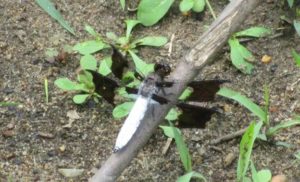
Some kind of dragonfly in the garden.
Joe Sapia, 60, is a lifelong Monroe resident. He is a Pine Barrens naturalist and an organic vegetable-fruit gardener.
He gardens the same backyard plot as did his Italian-American father, Joe Sr., and his Polish-immigrant, maternal grandmother, Annie Poznanski Onda. Both are inspirations for his food gardening. Joe is active with the Rutgers University Master Gardeners/Middlesex County program. He draws inspiration on the Pine Barrens around Helmetta from his mother, Sophie Onda Sapia, who lived her whole life in these Pines, and his Grandma Annie. Joe’s work also is at @JosephSapia on Twitter.com, along with Facebook.com on the Jersey Midlands page.
Message and photos by Jamie Bruno.
Editor’s Note: The LRWP and coLAB arts are pleased to welcome Jamie Bruno to our work in New Brunswick. Jamie will join us for the next 9 months as our National Endowment for the Arts Resident Artist.

Hello Dear Reader. Happy to be writing to you today.
As the new Resident Artist with the Lower Raritan Watershed Partnership my work is to bring people to the river and bring the river to people. Increasing that knowledge and access increases people’s value of a healthy river and watershed. Much of my work will be dedicated to CoLAB Arts and LRWP’s existing programming such as Rail-Arts-River and Trash Troubadour, within which the already incredible experience of cleaning up a stream also becomes an experience in arts and culture.
I live in Newark, NJ. My most recent work has been focused around urban agriculture, food security, food waste management, and organizing for urban agriculture alliance development. I manage a small farmers market for a local nonprofit once a week at a hospital in Newark. My most recent artwork, “And all our dead can live again,” is a functioning geodesic dome that, in many ways, is a reaction to doing urban agriculture and local food development work in a post-industrial inner city.
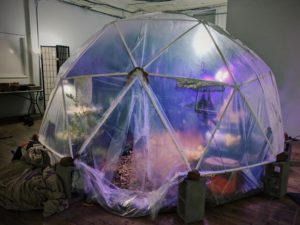
All Our Dead Can Live Again
As a graduate of Rutgers Mason Gross School of the Arts, I am already familiar with New Brunswick though I am still orienting to this new position and a changed city. My eyes see the river differently from the scientists, geologists and academics who study it. Slowly I will see more. For now I notice the strange interactions between humans and the human built riverfront. On my first trip re-visiting Boyd Park I see moments of departure in the landscape by an uncooperative nature, consistently unconcerned with our good intentions. And neglect by us, to simply sit and listen to her. I can’t wait to tell you more about that visit.
You don’t know me and I will only be with you, officially, for a short nine months. But within that nine months I hope that we can make sweet, passionate earth caring goodness together. Earth Care. People care. Future care. In the incredibly succinct lyrics of M.I.A.’s song “Meds and Feds”: We just “give a damn,” and, another inspiration, Y.A.L.A. (You Always Live Again as opposed to the formerly popular phrase, Y.O.L.O., You Only Live Once)… Earth karma.
Thank you for reading. If you’d like to see more of my work please visit tothedirt.net
Article and photos by Joe Mish
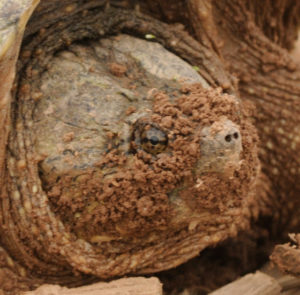
A snapping turtle mom in the process of laying eggs, remains motionless for hours, her body rising up as each egg is laid in the nest. Soil covers her face as a result of excavating a nest hole in which she will lay, according to several sources, 20 to 40 eggs.
I have always been fascinated with turtles, most likely because they were such strange animals, so different from anything else. They wore their skeleton on the outside, so in a way, they never left home even when they traveled. I learned the top shell was a carapace and the lower shell was a called a plastron. For a kid, way back when, to toss those words around, made people take notice and think the kid must be a budding genius. When asked, “what do you want to be when you grow up?” The answer was a quick, “I want to be a herpetologist!”, immediately followed by, “What’s a herpetologist?”.
A small book, A Golden Guide, Reptiles and Amphibians, was my constant companion. I studied the turtle section and noted the distribution of each species as shown in pink on a profile map of the USA. I was used to seeing painted turtles, musk turtles and snapping turtles when I went fishing, and box turtles a-plenty crossing roads on the way to the shore. There was an area in the nearby clay banks where slow flowing streams and spring fed ponds that drained into the river were overrun with spotted turtles.

A musk turtle sunning high above the water. Often when canoeing, a large splash of a musk turtle diving off a high branch causes a moment of mystery.
On occasion an uncommon turtle would cross my path. It was these rarely seen animals that really drew me in. There were wood turtles, Muhlenberg/Bog turtles and even a diamondback terrapin caught in a box style crab trap in Raritan Bay. These turtles being royalty; given their limited distribution.
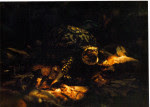
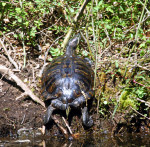
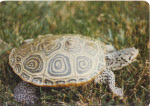
From top to bottom: A terrapin, red slider and eastern box turtles are a few of the turtle species found in NJ. Sliders and map turtles are working their way north via the Delaware Raritan canal.
As I got to know turtles and realized how long they live and how vulnerable they can be, I felt a kinship of sorts and became a guardian of these gentle creatures. When summer is about nigh, especially the first couple weeks of June, turtles are often seen crossing roads to traditional nesting grounds where the female will lay a batch of white leathery eggs in a hole she digs with her hind feet. This is when female turtles are most vulnerable to being crushed on the roadways. I stay alert to avoid adding to the carnage and will help a turtle cross a road in the direction she is headed, when I can safely do so.
Considering some females may not reach maturity for 8 to 10 years, as in the case of the wood turtle, each lost female represents a devastating blow to an already threatened species.
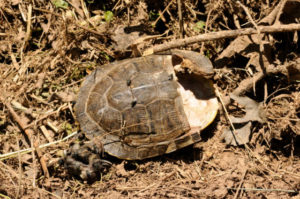
This wood turtle on her way to lay eggs was killed by a mower. Considering she was at least 10 years old the situation is even more tragic.
Turtle nests may be found hundreds of yards from any pond, river or stream. Telltale signs of a nest will be the curled fragments of the white egg cases scattered around a small hole after hatching. Otherwise you will never find a nest unless you see a turtle laying eggs or a nest dug up by a fox.
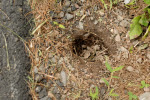
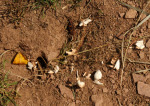
Scattered scraps of leathery turtle eggs post hatching, are often the only clue of a turtle nest. A typical turtle nest hole. This was made by a wood turtle.
I recently discovered that several map turtles have been using my yard and surrounding properties as a nesting ground. Map turtles were previously only found in southern New Jersey but have moved north primarily via the Delaware Raritan canal to the Millstone and Raritan rivers. These turtles are travelling at least 400 yards uphill through thick grass to dig nests. Imagine the journey the little guys have to survive as they follow their internal GPS back to the river.

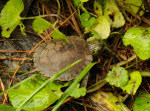
A painted turtle (top) and map turtle hatchlings make their way thru heavy grass and brush to the river.
I was fortunate to come across a snapping turtle laying eggs in a recently planted cornfield. The hours long process of laying, covering and paving over the nest by the female was captured on a GoPro camera. It is distilled down to 6 minutes and can be viewed at http://winterbearrising.wordpress.com/
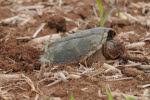
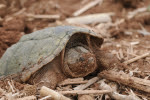
A snapping turtle lays eggs in a corn field. An hours long process where she is vulnerable to predators.
As the incubation period for most turtles can vary greatly, expect a hatch to occur from late August to September. Sometimes the hatch will not occur until the next spring. The cooler the weather during incubation period produces more males and females when weather is warmer. Across turtle species, the females reach productive maturity, in some cases, years after the males.
So be alert for nesting areas and local migrations during the nesting and hatching periods. Your yard could be a turtle nursery and you might not even know it. Be kind to our turtles and honor the legacy handed down from the Unami, a matriarchal branch of the Lenapes, known as the turtle people which inhabited this part of the state.
Author Joe Mish has been running wild in New Jersey since childhood when he found ways to escape his mother’s watchful eyes. He continues to trek the swamps, rivers and thickets seeking to share, with the residents and visitors, all of the state’s natural beauty hidden within full view. To read more of his writing and view more of his gorgeous photographs visit Winter Bear Rising, his wordpress blog. Joe’s series “Nature on the Raritan, Hidden in Plain View” runs monthly as part of the LRWP “Voices of the Watershed” series. Writing and photos used with permission from the author.
Article and photos by Joe Sapia
Note: The yard references are to my house in the section of Monroe between Helmetta and Jamesburg in South Middlesex County. My yard is in a Pine Barrens outlier on the Inner Coastal Plain, the soil is loamy, and my neighborhood is on the boundary of Gardening Zones 6b (cooler) and 7a (warmer). Afield references are to the Pine Barrens around Helmetta, unless otherwise noted. Notes and photographs are for the period covered, unless otherwise noted.
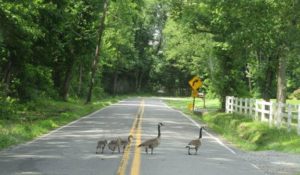
Mama and Papa Canada geese, “Branta canadensis,” and their young cross a road in the Dayton section of South Brunswick, Middlesex County, and stop my Jeep in its tracks. Silly geese! (On a serious note, humans could learn from the dedicated parenting of Canada geese.)
GOOD TO BE BACK HOME: Sorry for missing last week’s “Garden and Afield,” but I was down in New Orleans or traveling to and from. I was attending receptions for a medical residency graduation (of Dr. Anthony M. Sciascia II, the son of my college buddy) and wedding (of Anthony and Nancy). I had a wonderful time with the Sciascia clan who has treated me as family since our Marquette University days that began more than 40 years ago. But I always enjoy getting back home….
SOME N’AWLINS FLAVOR IN THE JERSEY MIDLANDS: New Orleans is known for its coffee made from the roots of chicory, “Cichorium intybus.” Well, guess what has began blooming in the Jersey Midlands? Chicory, the blue flower along roadsides and other disturbed areas. It is a foreign species naturalized here. That is, a weed. But a weed with a nice-looking flower.
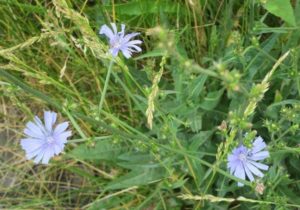
Chicory growing on a Monroe roadside.
IN THE GARDEN: While I was gone, my garden did not get its daily watering, even more critical because we had some very hot temperatures, near 100! But I began harvesting lettuce in earnest.
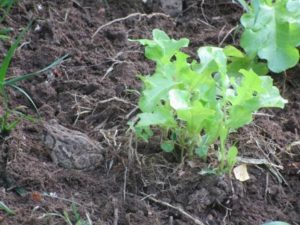
Lake Valley Seeds’s “Salad Bowl Green Heirloom Lettuce” grows in my garden. Next to the lettuce is nature’s pesticide, a toad — probably an American toad, “Anaxyrus americanus.” (Thanks to Sam Skinner, a Monmouth County Park System naturalist who set me in the right direction on the tentative identification of this toad.)
MY ORGANIC GARDEN: I just mentioned the wild toad as a natural pesticide. But, nowadays, people seem to be touchy over the term “organic,” arguing its meaning or arguing that “organic” does not mean purely natural. As I was taught in journalism, say exactly what you mean, rather than using labels. So, here is how I food garden – I add nothing to the mix except water.
MANALAPAN BROOK: The Brook flows about 400 feet from my front yard, but, thankfully, I am about 150 feet from its floodplain – so, close enough to enjoy the waterway, but far enough away not to be affected by flooding. This time of year, the Brook has a summer feel, with lush vegetation growing in the floodplain and, on this day, bright sunlight creeping through the trees. My section of the Brook is between “Jamesburg Lake” (Lake Manalapan) and “Spotswood Lake” (DeVoe Lake). Its watershed drains 40.7 square miles, according to the United States Geological Survey, in Middlesex and Monmouth Counties.
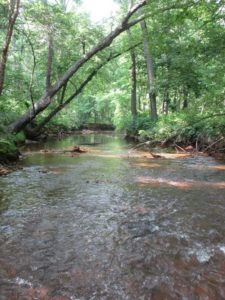
Manalapan Brook, looking downstream toward Helmetta
LIGHTNING BUGS: I saw the first lightning bug, a member of the “Lampyridae” insect family, of the season June 4. On June 17, as I was putting together this “Garden and Afield,” I watched fireflies in my backyard. There seemed to be more than normal, maybe a half-dozen to a dozen, but not the numbers I remember when I was a kid. They flash to signal mates.
ELSEWHERE IN THE YARD: Also in the yard over the last two weeks were rabbit, genus “Lepus”; the state bird, the Eastern goldfinch, “Spinus tristis,”; and my friend, the catbird, “Dumetella carolinensis.” The rabbits allow me to get within a few feet of them, probably because I go about my normal business, not TRYING to get close. The male goldfinch is brightly colored, a beautiful bird – “wild canaries” in the yard. I love catbirds. When I work in the yard or hike the Pine Barrens around Helmetta, catbirds perch nearby and keep me company.
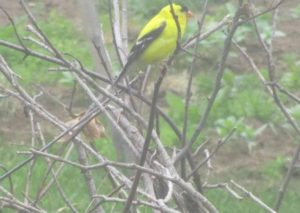
An Eastern goldfinch. Brightly colored, so it is a male.
WHITE ORCHID: Faye Bray, a friend from the Outdoor Club of South Jersey, reported a rare white variety of the pink lady-slipper orchid, “Cypripedium acaule,” in the Whitesbog, Burlington County, area of the Pine Barrens. “It’s freaking remarkable,” Faye said. (Unfortunately, we could not get a photograph for “Garden and Afield.”)
TURTLES: Turtles have been laying eggs, meaning females have been moving around. On my trip to and from New Orleans, I saw a half-dozen or so dead along the Interstate highways, apparently struck by vehicles. Up here in the Midlands, I have heard of various encounters with turtles. One, a person moved a box turtle, “Terrapene carolina,” to water. Wait, a box turtle is a land animal. Two, another person moved a snapping turtle, “Chelydra serpentina,” to a pond, possibly interrupting its egg-laying. So, my advice is, unless there is a compelling reason, leave wildlife alone. Generally, it knows what it is doing, it does not need humans to mess up its life.
TICKS: Ticks are bad this year. Essentially, they cling to vegetation and wait for a mammal to brush by them, then they attach. We have three ticks locally: deer tick, “Ixodes scapularis”; lone star tick, “Amblyomma americanum,” The female is easily distnguishable by the light-colored dot on her back; wood tick, also known as the dog tick, “Dermacentor variabilis.”
Get a tick ID pocket card. It will show the size and colors of not only these ticks, but in different stages of development. See http://www.tickencounter.org/tick_identification/guide.
There is no need to panic. Tick-borne diseases are relatively rare — I mean, if everyone in range of a tick, or even bitten by a tick, were to get sick, there would be a very sick population. However, be vigilant. In the yard, keep grass trimmed. If in the woods, take precautions by dressing properly. (If I am wearing long pants, for example, I tuck them in my socks.) And check for ticks on one’s body. When coming in from the woods or other places ticks are likely, wash the clothes and bathe as soon as possible.
If a tick is crawling on oneself, simply flick it off — It may take a few tries. If one is attached, take tweezers and grab it behind the head and pull it out. Then flush it down the toilet, throw it in a fire, or, if needed for observation, put it with an alcohol-doused cotton swab in a closed container.
If bitten, observe the bite for abnormalities, such as the Lyme Disease bull’s eye, seek medical help if concerned. The big tick disease locally is Lyme. However, New Jersey is now watching for Powassan virus.
My yard is wildlife-friendly and I take no special precautions in the yard, other than observing my clothes and body. I am always in the woods and fields, I found one tick on my body this season, but 10x or 20x that on my clothes — the point being, notice them before they get on one’s body.
Regarding the yard, keep the grass cut. I have tall-grass wildlife patches in my yard and have not found a tick on me yet while doing yardwork, etc. I would be more concerned with cats and dogs bringing them inside.
If you look them up online, use the scientific name, so as not to confuse species and colloquial names.
LETHAL ANIMALS: I would say on a daily basis, the three most lethal animals in the Pine Barens around Helmetta are the tick, mosquito, and pet dog. The former two could do a number for life, while the latter one could be hurtful for the moment.
In the Piedmont region of the Jersey Midlands, I would add copperhead snake, “Agkistrodon contortrix.” In the main Pine Barrens, the rattlesnake, “Croatus horridus.” But the chances of getting bit by either is rare.
Throughout the Midlands, a wandering black bear, “Ursus americanus,” could be a threat – but unlikely. If you see one, stay clear and that should be enough.
YOU SAY “MUSKMELON,” I SAY “MUSHMELON”: My friend Virginia Lamb, who I have turned to for advice (environmental, gardening, and general) over the years, said in reference to my using “mushmelon,” “It’s ‘muskmelon, not ‘mushmelon.’” She is correct, in a more formal sense. But I am correct, too, in a more informal way. So, I responded in an e-mail, “Local colloquialism = mushmelon. I use that only in my blog. Normally, when I talk, I say cantaloupe. (Kind of like the colloquialism “garden snake” for “garter snake.)” Yes, we are all talking cantaloupe.
SCIENTIFIC NAMES: My use of scientific names also has prompted some discussion. Sunil Nair, who has followed my Internet nature posts, said, “Love the fact that you write the genus names, too.” But Virginia Lamb noted, “Just a note on reader preference: I feel the Latin names interrupt the folksy flow of the prose and would prefer they be noted at the end. But that may just be me.” I am considering Virginia’s point. As for using scientific names, I do it so there is no question what is being discussed. “Swamp pink” could be the “Arethusa bulbosa” orchid or it could be the “Helonias bullata” lily. But a scientific name is a scientific name is a scientific name.
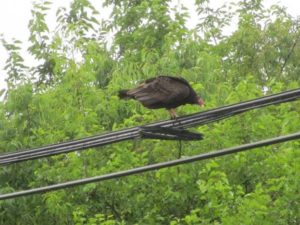
A turkey vulture, “Cathartes aura,” sits on a roadside utility line in Monroe after I spooked it when it was eating a dead ground hog, “Marmota monax.” Here, it is easily identified by its red head. Turkey vultures are commonly seen, soaring in a circle, their wings tipped into a V.
SUNRISE/SUNSET: For June 18, Sunday, to June 24, Saturday, the sun will rise between 5:25 and 5:30 a.m. and set about 8:30 p.m.
DATE TO KEEP IN MIND, JUNE 21: The longest daylight of the year is Wednesday, June 21, the summer solstice, when the sun rises at 5:28 a.m. and sets at 8:31 p.m. After June 21, daylight gets shorter.
DATE TO KEEP IN MIND, JUNE 24: St. John the Baptist Day. Sophie Majka, a neighbor who died March 8 at 92-years-old, had told me blueberries are ready to pick in the Pine Barrens around Helmetta on St. John’s Day, June 24. So, that is a target I look to.
WEATHER: The National Weather Service forecasting station for the area is at http://www.weather.gov/phi/.
SOURCES: As you can see, I have already mentioned various sources of information. Additionally, I enjoy listening to Mike McGrath’s “You Bet Your Garden” radio show on WHYY, 90.9 FM, out of Philadelphia – or on the Internet at http://whyy.org/cms/youbetyourgarden/. I also read Sally McCabe’s “In the Garden, It’s Time To…” column in the Philadelphia Inquirer newspaper, or on the Internet at philly.com.
MORE N’AWLINS FLAVOR IN HELMETTA: Why do I love traveling in the South? Maybe because I am a boy of the South – South Middlesex County. And my local roots go back to Helmetta, whose founder, for lack of a better term, George Washington Helme, was a Confederate military officer. Although a native of Kingston, Pennsylvania, Helme was a New Orleans resident during the Civil War. After the war, he came up to Helmetta, where his wife’s, Margaret Appleby Helme’s, family had a snuff mill operation – one that George would eventually take over. The George W. Helme Snuff Mill provided my family with work for approximately 75 years, from circa 1900 to 1976. The mill stopped manufacturing snuff in 1993 and, now, it is being converted into housing.
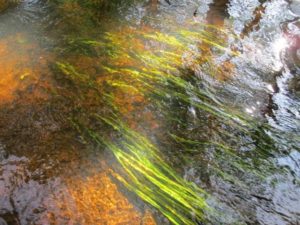
Looking into sunlit Manalapan Brook, here between Helmetta and Jamesburg.
Joe Sapia, 60, is a lifelong Monroe resident. He is a Pine Barrens naturalist and an organic vegetable-fruit gardener.
He gardens the same backyard plot as did his Italian-American father, Joe Sr., and his Polish-immigrant, maternal grandmother, Annie Poznanski Onda. Both are inspirations for his food gardening. Joe is active with the Rutgers University Master Gardeners/Middlesex County program. He draws inspiration on the Pine Barrens around Helmetta from his mother, Sophie Onda Sapia, who lived her whole life in these Pines, and his Grandma Annie. Joe’s work also is at @JosephSapia on Twitter.com, along with Facebook.com on the Jersey Midlands page.
Article and photos by Joe Sapia
Note: The yard references are to my house in the section of Monroe between Helmetta and Jamesburg in South Middlesex County. My yard is in a Pine Barrens outlier on the Inner Coastal Plain, the soil is loamy, and my neighborhood is on the boundary of Gardening Zones 6b (cooler) and 7a (warmer). Afield references are to the Pine Barrens around Helmetta, unless otherwise noted. Notes and photographs are for the period covered, unless otherwise noted.
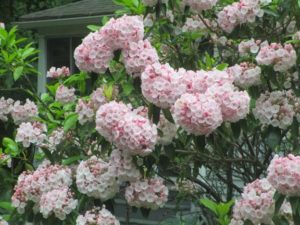
Mountain laurel, “Kalmia latifolia,” in bloom in the Pine Barrens around Helmetta, specifically the Jamesburg Park section of East Brunswick, Middlesex County.
MORE MOUNTAIN LAUREL LORE: I have mentioned here before the Pine Barrens lore I had heard, “The snapping turtle lays its eggs when mountain laurel blooms.” Here is some woods lore I just heard, “The deer would give birth around the time mountain laurel blooms.”
If you find a fawn, “Odocoileus virginianus,” seemingly by itself, leave it. Its mother is probably nearby, waiting for you to leave. If you come across a snapper, “Chelydra serpentine,” that needs to be moved from, say, a road, move it to safety in the direction it is traveling. It probably is a female, heading to uplands to lay eggs or returning to water after laying eggs. BE CAREFUL WITH SNAPPERS. More Piney lore, “Only the setting sun or lightning makes a snapping turtle let go.” I move them with a shovel, preferably a big grain shovel. Joey lore, “If a snapping turtle bites and will not let go, shove a wire in its nostril. Or maybe a flashing light will make it let go.”
Wild mountain laurel is virtually impossible to transplant.
Mountain laurel’s scientific name is “Kalmia latifolia.” The genus name comes from Pehr Kalm, a European botanist who worked in the South Jersey area in the 1700s. He published the influential “Travels into North America.” The plant’s species name is Latin for “broad-leaved.”
A SHORE GARDEN: On a newspaper reporting freelance story, I was at the home of artist Laura Petrovich-Cheney and her husband, educator and craftsman Peter Cheney, in Asbury Park, Monmouth County. Their property is on Deal Lake. There, a great egret, “Ardea alba”, and red-winged blackbird, “Agelaius phoeniceus,” flew along the lake. Purple martins, “Progne subis,” nest in houses on the property. In the gardens were various flowers in bloom: roses, poppies, daylilies (budding), peonies, yarrow, and trumpet vine honeysuckle. Also in gardens were Tears of Mary, tomato, eggplant, cucumbers, herbs, raspberry bushes, and a fig tree.
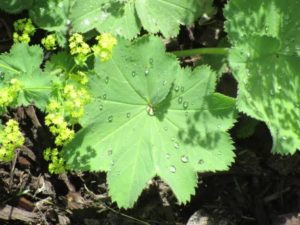
“Tears of Mary” plant in the Petrovich-Cheney and Cheney garden in Asbury Park, Monmouth County.
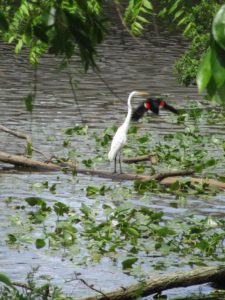
A red-winged blackbird flies past a great egret on Deal Lake at the Cheney and Petrovich-Cheney garden.
BIRD BATHS IN THE YARD: When my birdbath broke a few years ago, I took the bath part and laid it on the ground. When that had seen its days, I started using a garbage can lid, laying it on the ground. Now, I use large saucers – two in the backyard along the fruit and vegetable garden and one in the front yard. They are used by various animals: bird; squirrel; “Sciurus carolinensis”; and neighborhood cat, maybe even by skunk, “Mephitis mephitis”; chipmunk, “Tamias striatus”; raccoon, “Procyon lotor”; and ground hog, “Marmota monax.”
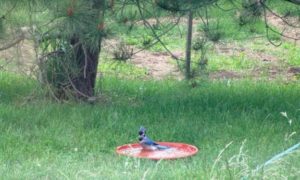
A blue jay, “Cyanocitta cristata,” in one of my backyard bird baths.
WATERING THE GARDEN: I water the garden before 10 a.m. so as not to lose water to evaporation in the heat of the day and so the garden dries by nightfall, preventing fungal growth. I use two watering methods – one, by sprinkling can if I have enough clean water accumulated (from rain, the cellar de-humidifier, and so on) and, two, by running a sprinkler. Sitting there with a cup of coffee and watching the sprinkler go back and forth is so relaxing. This week, a mourning dove, “Zenaida macroura,” joined me.
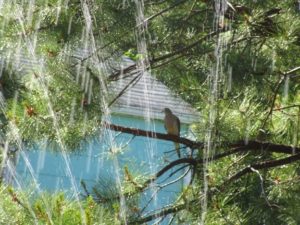
A mourning dove perches in a pitch pine – “Pinus rigida,” transplanted to my backyard from a Pine Barrens woods in Monmouth County – and hangs out with me as I watched the sprinkler water the garden.
BUTTERFLIES: As I have mentioned before, I am noticing a lot of tiger swallowtails, “Papilio glaucus,” the females black and the males yellow, this year. I usually cannot shoot a good photograph because they do not sit still. This week around my garden, I had a very cooperative female, allowing me to photograph away.
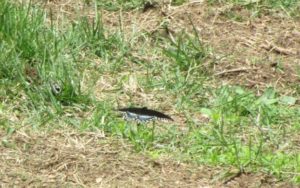
A female tiger swallowtail cruises over my garden.
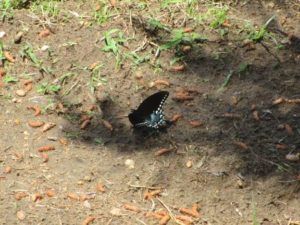
She rests in the garden.
DELAWARE RIVER AT FIELDSBORO: I was along the Delaware River near Fieldsboro, Burlington County. This is where the river transforms from commercial shipping (here and south) to recreational (here and north). Although the water here is fresh, there is a tidal effect as far north on the river as the area of Trenton, Mercer County.
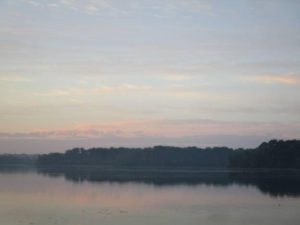
Dawn on the Delaware River, looking toward the area of Fieldsboro, Burlington County.
CLOUDS: Over the last several months, clouds have been spectacular. On the evening of May 31, Wednesday, I was along the Delaware River in the Fieldsboro area. It was clear where I was, but to the north were storm clouds with occasional streaks of lightning. The lightning was too sporadic for me to catch a photograph, but I shot pictures of the storm clouds and sunset. (Tip on photographing lightning: If the lightning is flashing near enough to one another, do not try to catch the flash. Instead, just keep on cranking pictures and hopefully there will be a usable shot of lighting in the batch – and hopefully you were not struck by lightning!)

Man in the cloud blows fire at a jet along the Delaware River.
LIGHTNING: A few years back, a Jersey Shore beachgoer at the Atlantic Ocean in clear weather was struck and killed by “out of the blue lightning” because, despite the clear weather at the beach, a thunderstorm was near enough. So, play it safe. The rule I follow, “If you hear thunder, you can be struck by lightning.” Seek cover.
NIGHT SKY: At dawn, look for the bright “star” in the East – the planet Venus. The Full Rose Moon is Friday, June 9. On Saturday, June 3, I stood on my back porch and looked at the moon, with the planet Jupiter just off it. I find it fascinating I can stand in my yard and look at the wonders of the night sky in the home I grew up in – and followed the USA-Soviet Union “Space Race” in the 1960s. Turn off the outside lights, let your eyes adjust for 20 minutes to 30 minutes, and enjoy a naked-eye view of the Night Sky.

The planet Jupiter aligned with the moon on the night of Saturday, June 3.
UNDER THE PORCH: After working an overnight shift, I came home to find a pile of dirt under one of my back porches, the one at the Florida room. Enough dirt in the pile to fill a wheelbarrow. I suspect a ground hog. I raked up the dirt and moved it to my garden, where I likely will rake it out in the fall. As for the animal hole, I let it be. Wildlife is welcome in my yard, but I prefer it does not mess with my vegetable-fruit garden.

The work of a ground hog, I presume.
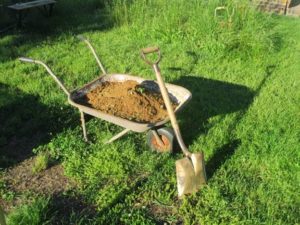
Off to the garden with the dirt. I can always find a use for it.
SUNRISE/SUNSET: For June 4, Sunday, to June 17, Saturday, the sun will rise about 5:30 a.m. and set about 8:25 p.m.
WEATHER: The National Weather Service forecasting station for the area is at http://www.weather.gov/phi/.
MY GARDEN: I continue with the three Ws – water, weed, and wait. The cool weather plants of lettuce and carrot are growing nicely, but the pea are lame. As for the warm weather plants, cucumber, mushmelon, and sweet corn, along with zinnia, are poking through the ground. No sign yet of tomato. (And I am thinking I may abandon planting tomato from seed. I am considering for next year buying plants and transplanting them into the garden.)
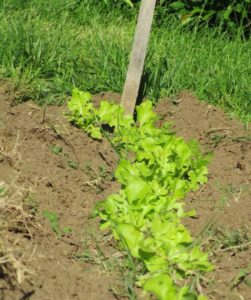
Salad Bowl Lettuce,” by Lake Valley Seed, growing in my garden.
UPCOMING “GARDEN AND AFIELDS”: After I publish a “Notes from Garden and Afield,” I panic, thinking, Will I be able to fill next week’s issue? Then, I realize there is plenty happening afield and in the garden. Alas, because of a scheduling conflict I have, “Notes from Garden and Afield” will not publish June 11. The plan is for it to return June 18. Meanwhile, check out on your own what is happening afield and in the garden.
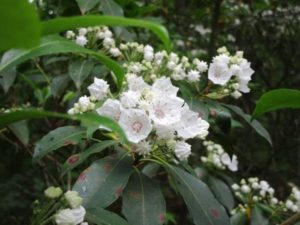
Mountain laurel, in bloom and about to bloom fully, in Jamesburg Park.
Joe Sapia, 60, is a lifelong Monroe resident. He is a Pine Barrens naturalist and an organic vegetable-fruit gardener.
He gardens the same backyard plot as did his Italian-American father, Joe Sr., and his Polish-immigrant, maternal grandmother, Annie Poznanski Onda. Both are inspirations for his food gardening. Joe is active with the Rutgers University Master Gardeners/Middlesex County program. He draws inspiration on the Pine Barrens around Helmetta from his mother, Sophie Onda Sapia, who lived her whole life in these Pines, and his Grandma Annie. Joe’s work also is at @JosephSapia on Twitter.com, along with Facebook.com on the Jersey Midlands page.
Article and photos by Joe Mish
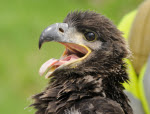
Three generations of eagles have cast their shadows over the land along the South Branch. Eagles are often seen but not recognized because the white head and tail are not developed until the 4th or 5th year.
A large dark bird perched on a light gray branch of a dead tree that hung low over the South Branch. I was quite a distance upriver, my attention focused navigating the shallow water when I caught sight of that dark, solid brown bird. Thinking it was a large hawk, I pulled the camera from the bag in the event I might get near enough for a photo. I aligned the canoe with the current when I was quite close, traded the paddle for the camera and began to click away. I drifted directly under the co-operative bird and began to wonder at the exceptionally large beak. I couldn’t imagine that after viewing the images online, I had been in the presence of a juvenile bald eagle.
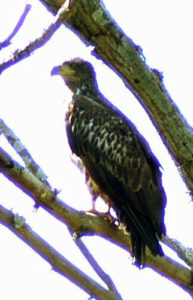
That event occurred in the spring of 2011. It was the very first time I ever saw an eagle on the South Branch and almost discounted it as an oversized, unidentified hawk.
Since 2011, I had been seeing more eagles of different age groups in that same area and in December of 2014, the first sticks were assembled into a nest. By late March 2015 eggs were being incubated and two eaglets hatched in April and banded in May with green aluminum bands E14 and E15.
Up to that point eagles had existed for most people only as a concept or an image on coin of the realm or marketed products with a patriotic flare.
The question now on eagle watcher’s minds after the 2015 success was what would happen next year? Would the eagles return? Would they use the same nest? Was the nest too close to human activity and be abandoned?
Late December 2015 a pair of adults thought to be the same eagles from the previous year, began to build a new nest opposite the old nest. It seemed quite a random decision and in human terms, spiked with a heavy dose of humor attributed to the obsessive behavior of one of the pair. they have a perfectly good nest, why are they building another?
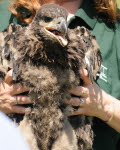
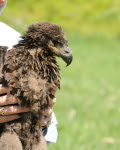
Eagles have been known to build nests and not use them, sometimes called, practice nests, as a best guess. In any event, the nest went up in record time and another pair of eagles hatched, banded and fledged in the spring of 2016. That year the eaglets were banded with green bands bearing E43 and E44.
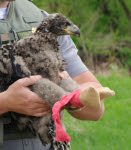
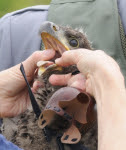
Reputed to mate for life, eagles tend to go separate ways after raising their young, often to far off destinations. One of a local pair had been tracked to Long island and the other to
Philadelphia. Given the vagaries of nature, sickness, accident and foul play it is somewhat miraculous they meet again, same time, same place, to raise another brood.
In late 2016 the eagle’s nest was destroyed and hearts sank for the production a third generation of new eagles on the South Branch.
Our eagles would not let us down as sticks began to reappear and another new nest was constructed. Speculation was ripe with concern that it was too late or the disturbance would discourage the eagles from mating and laying eggs. Right on schedule eggs were laid and two eaglets hatched in the spring of 2017. Banding took place in May and green bands E57 and E58 were affixed to the legs of a feisty pair of 2017 South Branch graduates.
Three years in a row, two eagles produced and fledged six offspring along the South Branch. In that nest they delivered three generations of eagles to someday impress the children of today’s children with the spectacular view of a wild and free eagle casting its shadow across the land.
This eagle pair has demonstrated persistence, patience, devotion and tolerance with their presence along the South Branch; Qualities that would serve all communities well to embrace.
Author’s note: See winterbearrising.wordpress.com bottom of gallery2, for age difference by plumage and a video snippet from the 2017 eagle banding.
Author Joe Mish has been running wild in New Jersey since childhood when he found ways to escape his mother’s watchful eyes. He continues to trek the swamps, rivers and thickets seeking to share, with the residents and visitors, all of the state’s natural beauty hidden within full view. To read more of his writing and view more of his gorgeous photographs visit Winter Bear Rising, his wordpress blog. Joe’s series “Nature on the Raritan, Hidden in Plain View” runs monthly as part of the LRWP “Voices of the Watershed” series. Writing and photos used with permission from the author.
Article and Photos by Joe Sapia
Note: The yard references are to my house in the section of Monroe between Helmetta and Jamesburg in South Middlesex County. My yard is in a Pine Barrens outlier on the Inner Coastal Plain, the soil is loamy, and my neighborhood is on the boundary of Gardening Zones 6b (cooler) and 7a (warmer). Afield references are to the Pine Barrens around Helmetta, unless otherwise noted. Photographs are for the period covered, unless otherwise noted.
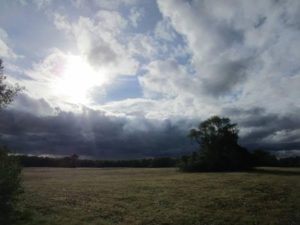
The Van Dyke Farm at Pigeon Swamp, South Brunswick/Middlesex County, where growing crops meets the woods.
VAN DYKE FARM: A favorite place to shoot photographs of mine is the Van Dyke Farm at Pigeon Swamp in South Brunswick/Middlesex County. It offers big-sky views to the west and the setting sun. See http://www.middlesexcountynj.gov/About/ParksRecreation/Pages/PR/VanDyke.aspx.
SOURLAND MOUNTAIN: I hiked one of my favorite Midlands places, Sourland Mountain on the boundary of Somerset, Hunterdon, and Mercer counties with a club I have been a member of for about 35 years, the Outdoor Club of South Jersey. On the mountain, I saw various flowers in bloom: showy orchid, “Galearis spectabilis,”; rue anemone, “Anemonella thalictroides”; and spring beauties, “”Claytonia virginica.” Being on the Piedmont with its rocky terrain, Sourland Mountain is much different than my generally flat and sandy Pine Barrens around Helmetta.
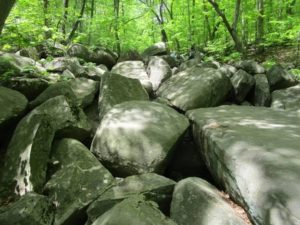
The Roaring Rocks boulder field on Sourland Mountain. Notice the hikers in the upper part of the photo.
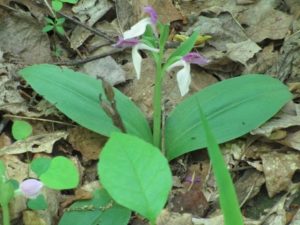
A showy orchid on Sourland Mountain
FLATLANDERS VERSUS HILLTOPPERS: For purposes of this writing, New Jersey has four geological areas, which run northeast to southwest: from west to east, Ridges and Valleys, Highlands, Piedmont, and Coastal Plain. (The Coastal Plain can be divided into two areas, Inner and Outer, making it five regions.) Generally, the Midlands are divided into the Piedmont and Coastal Plain, with distinct characteristics. The generally flat Coastal Plain has white, sandy soil (think Shore and Pine Barrens) and dark soil (think conventional farming areas). The rolling Piedmont has red shale and traprock boulders.
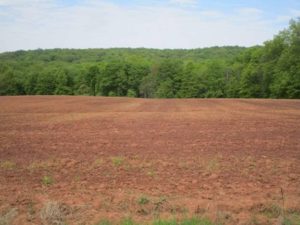
Piedmont red shale at Sourland Mountain, which is in the background.
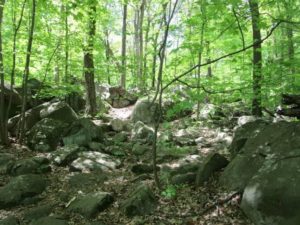
Traprock boulders on Sourland Mountain.
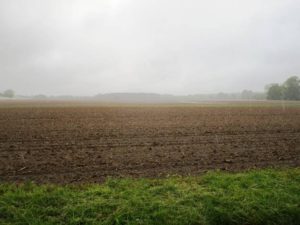
Coastal Plain dark soil at Cranbury/Middlesex County.
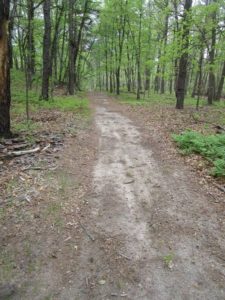
White, sandy soil in the Pine Barrens of Helmetta on the Coastal Plain.
FULL MOON AND PLANTING: The full moon was May 10, Wednesday, and some feel it is OK, now, to plant warm weather crops. Not me, especially with the cooler weather we have been having. I am still waiting for May 20 (if it warms up) to June 1 (if it remains on the cool side). Then, I will plant my warmer season crop – tomatoes, mushmellon, sweet corn, and cucumbers, along with zinnias to attract pollinators and for their beauty.
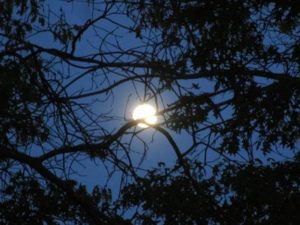
The near-Full Corn-Planting Moon. The full moon was Wednesday, May 10.
FOOD GARDEN: I weeded for the first time around the cool weather crops — “Salad Bowl” heirloom lettuce, “Rainbow Blend” carrots, and “Sugar Daddy” snap peas, all “Lake Valley Seed Company” brand — that have sprouted. I continue watering the garden.
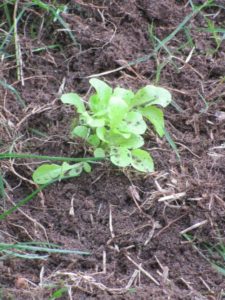
Lake Valley Seed Company “Salad Bowl” heirloom lettuce growing in my garden.
WATERING THE FOOD GARDEN: My goal is to give the food garden a thorough watering by 10 a.m. This allows the garden to retain water, rather than have the water evaporate in the heat of day, and allows the garden to dry by the dewy nightfall to prevent fungal growth.
KEEPING WILDLIFE AWAY, CAYENNE PEPPER: I was talking a waitress at the Dayton Diner in South Brunswick/Middlesex County. An experienced gardener, she recommended using cayenne pepper as a method of pest control around the garden. I plan on trying that.
ALONG THE SOUTH RIVER: My travels took me across the South River at Old Bridge village on the boundary of Old Bridge, Sayreville, and East Brunswick, all in Middlesex County. On my way back, I stopped to shoot photographs between Old Bridge village and the New Causeway on the boundary of South River and Sayreville, both in Middlesex County. The South River is formed by the meeting of Manalapan and Matchaponix brooks on the Spotswood-Old Bridge boundary at DuHerNaL Lake/Middlesex County. (DuHerNaL Lake gets its name from the three companies that had used it as a reservoir: DuPont, Hercules, and National Lead.) Normally, I do not think of inland self, 25 or so miles from the Atlantic Ocean, living near salt water, but the tidal effect begins at the bottom of the DuHerNal Lake dam, only a little more than 4 miles from my house.
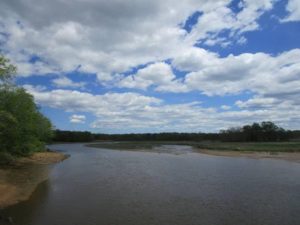
The South River at low tide at Old Bridge village.
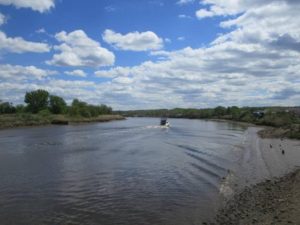
The South River at low tide at the New Causeway on the South River-Sayreville boundary. This scene looks upstream toward the railroad bridge and the South River Boat Club — Sayreville on the left, South River on the right.
KILLDEER: When I was at the South River at Cannon Brothers Park in South River, I spooked a killdeer, “Charadrius vociferous.” The species screeches a “kill-deer” call. Because of the way the bird was acting, panicked but not leaving the area, I suspect it had a nest nearby it was trying to divert me from. An adult killdeer will even fake a broken wing to get a predator to follow it, rather than have the predator attack the ground nest. I could not find a nest.
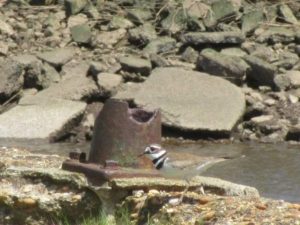
A killdeer along the South River in South River.
TURKEYS: Some thoughts from Bob Eriksen, the retired state turkey biologist, on “Meleagris gallopavo,” “…Wild turkeys that have adapted to suburbia will sometimes nest in among shrubs in a yard. I had one nest next to a gravestone in a cemetery. Most of the time turkey nests are in the woods or in an overgrown field. Hens will tuck in next to a tree trunk, at the base of a shrub, or in a blowdown, especially if there is a branch within a few feet. They like to have a bit of overhead cover. Once the grass in hayfields is tall enough to hide the hen crouched down (usually second week of May), a hen turkey will nest in a hayfield. Cover is the main consideration. Hens are pretty secretive approaching the nest. They may circle or use different approaches when they go to the nest to lay. When the clutch is large enough (10-12 eggs), she will begin to incubate. For the first couple of nights after she has completed her clutch, she may tree roost, but that changes fast. Once incubation begins, the hen will be on the nest 20 or more hours a day.” (A shout out to Bob for always being so helpful.)
JERSEY MIDLANDS LORE: Another good source of information is legendary Helmetta outdoorsman Ralph “Rusty” Richards, 84-years-old. During one of our occasional breakfasts of members of 100-year Helmetta families, Rusty was talking about deer-hunting. In the early part of the 20th Century, white-tailed deer, “Odocoileus virginianus,” were almost gone from New Jersey because of over-hunting. As the state brought them back, they gradually re-settled. About 1950, they were in the Broadway Woods area of South Brunswick/Middlesex County, only a few miles from Helmetta, according to Rusty. Then, about 1955, they were settled around Helmetta, Rusty said.
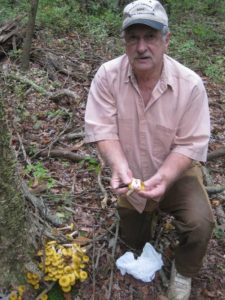
In 2011, Rusty Richards with “opienki” mushrooms, genus “Armillaria,” in the Pine Barrens around Helmetta.
BOBWHITE: Did I hear a bobwhite quail, “Colinus virginianus,” calling in my neighborhood? If so, it would have been a return to my childhood when one could hear the “Bob White” call at night. Bobwhites have become rare in New Jersey because of habitat loss, but, in recent years, there has been an effort to welcome them back. So, was it a wild bobwhite or not? I do not know….
TICKS: Reports are still coming in on how bad a tick season it is.
I am hearing reports of deer ticks, “Ixodes scapularis,” and lone star ticks, “Amblyomma americanum.” Various reasons may be causing the problem, including warm weather generating acorn growth and, in turn, the acorns providing abundant food to tick-carrying animals, along with the recent rainy weather. “More rain typically enhances tick season,” said meteorologist Steve DiMartino.
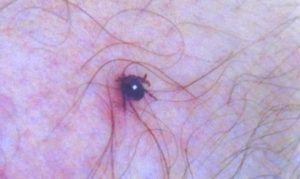
A lone star tick on my leg. Lone star ticks are easily identifiable by the yellow dot on their backs.
PINE BARRENS AROUND HELMETTA: Pink lady-slipper orchids, “Cypripedium acaule,” continue to bloom. I know of a spot that has about 75 lady-slippers, with about five in bloom. If you see a pink lady-slipper, look around for more in the area; I see them in clusters. And do not pick them!
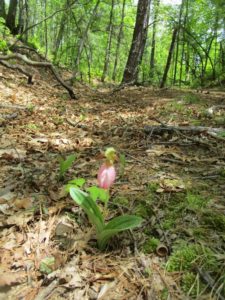
A blooming pink lady-slipper orchid, with another, left and to the rear of the blooming orchid, poking through the ground.
SUNRISE/SUNSET: For the week of May 14, Sunday, to May 20, Saturday, the sun will rise at about 5:40 a.m. and set at about 8:10 p.m.
WEATHER: Go to the National Weather Service forecasting station for the area, http://www.weather.gov/phi/.
THE END-OF-THE-WEEK RAIN: I look to a thorough rain around May 15 to green up the woods for the season. The steady, heavy rain of Saturday, May 13, should have accomplished that. By late Saturday night as the rain continued, my rain gauge showed 2.3 inches.
WEATHER: Go to the National Weather Service forecasting station for the area, http://www.weather.gov/phi/.
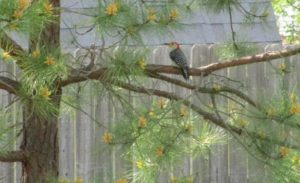
A red-bellied woodpecker, “Melanerpes carolinus,” sitting in a pitch pine, “Pinus rigida,” in my backyard.
Joe Sapia, 60, is a lifelong Monroe resident. He is a Pine Barrens naturalist and an organic vegetable-fruit gardener.
He gardens the same backyard plot as did his Italian-American father, Joe Sr., and his Polish-immigrant, maternal grandmother, Annie Poznanski Onda. Both are inspirations for his food gardening. Joe is active with the Rutgers University Master Gardeners/Middlesex County program. He draws inspiration on the Pine Barrens around Helmetta from his mother, Sophie Onda Sapia, who lived her whole life in these Pines, and his Grandma Annie.
Article and photos by Joe Sapia
Note: The yard references are to my house in the section of Monroe between Helmetta and Jamesburg in South Middlesex County. My yard is in a Pine Barrens outlier on the Inner Coastal Plain, the soil is loamy, and my neighborhood is on the boundary of Gardening Zones 6b (cooler) and 7a (warmer). Afield references are to the Pine Barrens around Helmetta, unless otherwise noted. Photographs are for the period covered, unless otherwise noted.
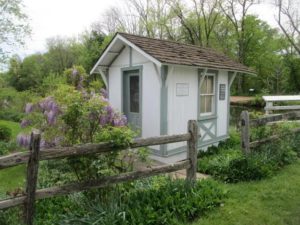
In the Delaware and Raritan State Park, the historic bridgetender station, circa 1830, and garden at Blackwells Mills in Franklin/Somerset County.
GARDEN AND YARD: In my food garden, peeking through the soil are cool weather vegetables of lettuce and carrots. I had not seen any noticeable sign of peas coming up, but Cranbury/Middlesex County farmer Roy Reinhardt advised me to be patient; He was right, there they were a few days later. Wild onions, “Allium canadense,” are coming up in my lawn; If only I enjoyed onions more than I do, I would have a nice bounty.

Wild onions growing in the yard.
RAIN: The rain May 5, Friday, was drenching. Kathy Krygier of Krygier’s Nursery in South Brunswick/Middlesex County reported about 1.75 inches. Other reports from the Jersey Midlands, via the wunderground.com website, include Lambertville/Hunterdon County, 1.63 inches; Somerville/Somerset County, 1.16 inches; the Mill Lake Manor section of Monroe, 2.05 inches; Little Silver/Monmouth County, 2.02 inches; Miller Air Park in Berkeley/Ocean County, 2.63 inches; the Chatsworth area/Burlington County, 1.62 inches; and Ewing/Mercer County, 1.63 inches.
UPCOMING FOOD GARDEN DATES: For planting the warm season crop, my rule of thumb is May 20 (in a warm season) to June 1 (in a cooler season), with steady overnight temperatures of 55 or higher. Some planters go by Mother’s Day (this year, May 14), some go by May 15. Helmetta farmer Timmy Mechkowski says after the May full moon – this year, this Wednesday, May 10, the Full Corn-Planting Moon.
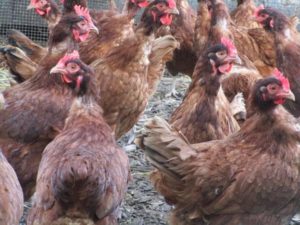
Rhode Island red chickens at the Mechkowski Farm in Helmetta.
INTERNATIONAL SPACE STATION: Possible sightings of the ISS are May 8, Monday, 4:47 a.m. to 4:50 a.m, tracking west southwest to north northeast; May 9, Tuesday, 3:57 a.m. to 3:59 a.m., south to east northeast; May 10, Wednesday, 4:40 a.m. to 4:44 a.m., west to north northeast; May 12, Friday, 4:32 a.m. to 4:36 a.m., west northwest to north northeast. Caution: One needs a clear sky and, at times, a clear view well above the horizon.
EGRET: I have noticed a great egret, “Ardea alba,” fly by my house two or three times in recent weeks, along with once about 1-1/2 miles away. I suspect it is the same bird. Just an interesting sighting.
TURKEY: A wild turkey, “Meleagris gallopavo,” greeted me when I turned onto my street.

A wild turkey in the neighborhood.
TICKS: Reports are coming in about ticks being out with a vengeance in New Jersey. I, for example, have pulled deer ticks, “Ixodes scapularis,” and lone star ticks, “Amblyomma americanum,” off my clothes. From Chris Bevins, “How are you making out with ticks? They are ferocious this year and first time I’m seeing lone star ticks in abundance.” And Frank Ulatowski says he had about a dozen on him or his clothes after being up at the Delaware Water Gap area.
PINE BARRENS AROUND HELMETTA: Pink lady-slipper orchids, “Cypripedium acaule,” are coming into bloom. Flowering dogwood, “Cornus florida,” remains in bloom. Pitch pine, “Pinus rigida,” have long “candles” of new growth. Cinammon fern, “Osmunda cinnamomea,” is in its fiddlehead state and unfurling. Northern gray treefrogs, “Hyla versicolor,” continue calling vociferously. Spring peeper treefrogs, “Pseudacris crucifer,” continue calling. Sunfish, genus “Lepomis,” guarded their nests at Helmetta Pond. Antlion larvae, “Hesperoleon abdominalis,” had pits to capture ants. And I captured a nice photo of some kind of dragonfly in the woods.
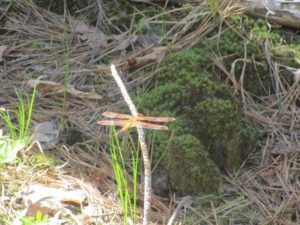
A dragonfly at Jamesburg Park/Middlesex County.
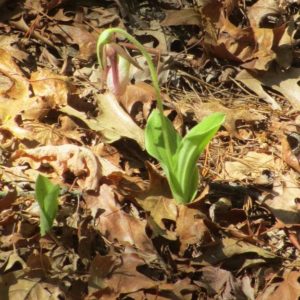
A pink lady-slipper orchid in bloom, right. Left, lady-slipper leaves poking through the ground.
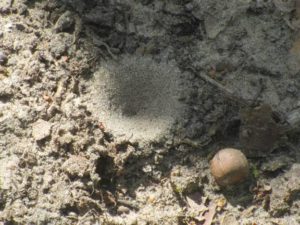
The pit of an antlion larva, or doodlebug. The larva sits in a pit awaiting a meal of an ant. The larva eventually evolves into a flying insect. To put the size of the pit in perspective, that is an acorn sitting nearby.
DELAWARE AND RARITAN CANAL: I visited a Franklin/Somerset County section of the D&R Canal State Park, specifically the area between Route 518 and Blackwells Mills. Various animals were active — great blue heron, “Ardea herodias”; Gray catbird, “Dumetella carolinensis”; redbelly turtles, “Pseudemys rubriventris.” Spring beauties, “Claytonia virginica,” remain in bloom. I saw as-big-as-my-forearm poison ivy, “Toxicodendron radicans” — “Hairy rope, don’t be a dope!” As a kid, I could touch it and not get a rash, but twice I got it bad as an adult years ago — perhaps it was because of the hot days, me sweating, my pores open. Now, I take no chances!
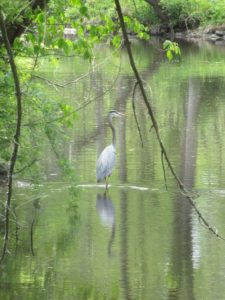
A great blue heron in the D&R Canal.
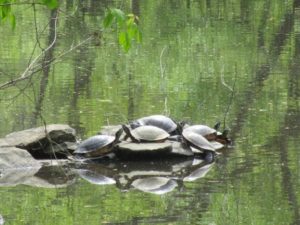
Basking redbelly turtles in the D&R Canal.
TURTLES CROSSING ROADS: A heads-up for turtles crossing roads. There has been a lot of reported movement lately. If driving, watch out for them. If trying to move them, one, do it safely and, two, move the turtle in the direction it was traveling. (For snapping turtles, “Chelydra serpentina,” BE CAREFUL. Some Piney lore, only lightning or the setting sun will make a snapper let go. Me, I use a grain shovel I keep in my Jeep to move snappers across roads.) I was driving through Pigeon Swamp in South Brunswick/Middlesex County recently and saw what I think was an eastern painted turtle, “Chrysemys picta,” crossing a road. By the time I turned around to move it, it was gone.
SUNRISE/SUNSET: For the week of May 7, Sunday, to May 13, Saturday, the sun will rise at about 5:45 a.m. and set at about 8:05 p.m.
WEATHER: Go to the National Weather Service forecasting station for the area, http://www.weather.gov/phi/.
UPCOMING AFIELD DATE: The first soaking rain around May 15 should green up the woods for the season.
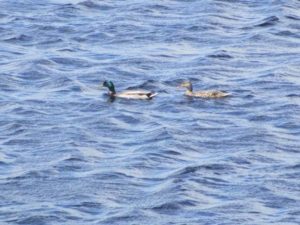
Mallards, “Anas platyrhynchos,” at Helmetta Pond. Left, the colorful male, and, right, the more drabby, brown female.
Joe Sapia, 60, is a lifelong Monroe resident. He is a Pine Barrens naturalist and an organic vegetable-fruit gardener.
He gardens the same backyard plot as did his Italian-American father, Joe Sr., and his Polish-immigrant, maternal grandmother, Annie Poznanski Onda. Both are inspirations for his food gardening. Joe is active with the Rutgers University Master Gardeners/Middlesex County program. He draws inspiration on the Pine Barrens around Helmetta from his mother, Sophie Onda Sapia, who lived her whole life in these Pines, and his Grandma Annie.
Water Protectors in Standing Rock, North Dakota protesting the Dakota Access Pipeline brought attention to serious flaws in the federal environmental review and approval process for crude oil and natural gas pipeline projects. The Water Protectors argued that all infrastructure projects need to include a truly comprehensive Environmental Impact Statement (EIS) that evaluates impacts to our natural and cultural assets.
While the federal oversights affecting Standing Rock were particularly egregious, the legacy of compromised Federal Energy Regulatory Commission (FERC) environmental review processes should be of concern to New Jersey residents as well. Oil and gas pipelines already fragment our environment as they crisscross the state. Our Lower Raritan Watershed may be impacted further by the proposed. This project includes a 3.4-mile-long, 26-inch-diameter pipeline loop in Middlesex County, and a 23.4-mile-long, 26-inch-diameter pipeline loop (called the “Raritan Bay Loop”) beginning at the Middlesex County coast and crossing New Jersey and New York State marine waters.

Because the Lower Raritan Watershed Partnership has concerns that the pipeline would have irreversible impacts on our communities, watershed ecology and marine habitat, we joined dozens of other concerned citizens and environmental groups at the April 20 meeting of the Middlesex County Freeholders to encourage elected officials to take action on a project that would pose significant risks. The Home News covered our public statements, and the Middlesex County Freeholder’s response.
And on April 25, the LRWP applied for intervenor status to address the Federal Energy Regulatory Commission (FERC) on the Williams/Transcontinental Application for the Northeast Supply Enhancement (NESE) Pipeline Project (Docket Number CP17-101). Becoming an intervenor provides legal standing in the proceeding, and obligates FERC to address any comments we may submit. The LRWP included the following in our application for intervenor status:
“The Transco Pipeline proposals pose significant risks to our Central New Jersey communities. These projects will solely benefit New York City markets, yet our New Jersey communities would bear significant public health and economic risks – including increased rates of leukemia, lymphomas, respiratory disorders and other diseases – while receiving little or no benefits. We must not expose our local communities to a high-risk proposition with little to no reward.
The Transco Pipeline proposals will harm our environment and the habitat of our Raritan Watershed and Raritan Bay. The building of pipeline infrastructure and the transport of natural gas from the Marcellus Shale region to New York will fragment our natural habitat, and disrupt commercial and recreational marine activities for residents and visitors. Our communities are working hard to restore landscapes destroyed by decades of industrial dumping and toxic pollution, let’s not reverse this positive trend.
The Transco Pipeline proposals are unnecessary. The Transco Pipeline would be a redundant expansion of industrial natural gas infrastructure through our Middlesex County, Somerset County and Bayshore communities. The LRWP recognizes that aging rail, bridge and other infrastructure that currently accommodates fuel transport poses risks that could lead to devastating spills in our waterways. This serious concern that can be addressed by two-pronged strategy: significant investment in the repair and maintenance of our existing infrastructure, and shifting investments to safe, clean renewable energy.
The Transco Pipeline proposals are not what our communities want. The overwhelmingly negative feedback on the project during community meetings has made it clear that this project does not have the support of community residents!”
Article and photos by Joe Sapia
Author’s note: The yard references are to my house in the section of Monroe between Helmetta and Jamesburg in South Middlesex County. My yard is in a Pine Barrens outlier on the Inner Coastal Plain, the soil is loamy, and my neighborhood is on the boundary of Gardening Zones 6b (cooler) and 7a (warmer). Afield references are to the Pine Barrens around Helmetta, unless otherwise noted.
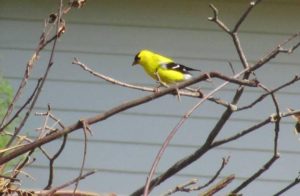
The New Jersey state bird, an Eastern goldfinch. Here, a male adult, distinguished by its bright colors.
THE NEW JERSEY STATE BIRD: I saw an adult male Eastern goldfinch, “Spinus tristis,” in the yard and he was in his bright mating colors of yellow, black and white. Females and juveniles are duller in color.
“SNOWBIRDS”: I may have seen the last of the dark-eyed juncos, “Junco hyemalis,” for the season about April 17. These “snowbirds” will head north, possibly as close as North Jersey or Pennsylvania, possibly as far as Canada, and not return until the fall. I normally see their return to my yard around Halloween.
OTHER BIRDS IN THE YARD: Robin, “Turdus migratorius,”; house finch, “Haemorhous mexicanus”; mourning dove, “Zenaida macroura”; cardinal, “Cardinalis cardinalis”; pigeon, probably “Columba livia”; tufted titmouse, “Baeolophus bicolor”; red-bellied woodpecker, “Melanerpes carolinus”; brown-headed cowbird, “Molothrus ater”; white-breasted nuthatch, “Sitta carolinensis”; and white-throated sparrow, “Zonotrichia albicollis.” The house finch and pigeon are non-native, but naturalized, species.
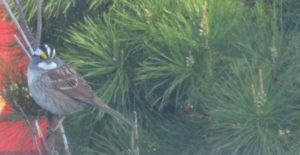
White-throated sparrow.
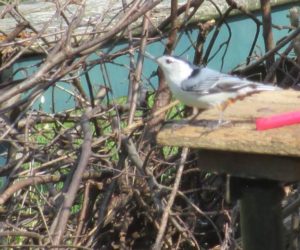
White-breasted nuthatch.
WHITE ROBIN: Hearing a report of a “white” robin in Cranbury Station on the boundary of Monroe and Cranbury, Middlesex County. Jean Wojaczyk describes it as having a pale orange chest and, basically, the rest being white.
BIRDBATHS: I got them filled at the normal backyard location and added another to the front yard. For years, I have used garbage can lids or shallow pans filled with water and placed directly on the ground.
HUMMINGBIRD FEEDER: Put it up April 16 to catch the “scout” hummingbirds, hoping to attract these early arrivals and, in turn, the others headed north. I have never been successful with hummingbirds, but I try again.
GREAT EGRET: Was able to photograph a great egret, “Ardea alba,” flying past my house.
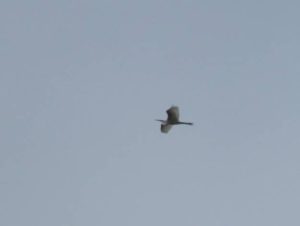
Great egret flying by my house.
PINE BARRENS AROUND HELMETTA: I walked the local Pines April 17 with Priscilla “Peppy” Bath, 85-years-old, of Hamilton Square, Mercer County. Peppy and I are longtime members of the Outdoor Club of South Jersey. Peppy and I observed quite a bit in our approximately 3-mile walk, including blooming trailing arbutus, “Epigaea repens,” whose flowers produce aeguably the nicest scent in the local pines; cinnamon fern, “Osmunda cinnamomea,” in its fiddlehead stage”; beautiful green skunk cabbage, “Symplocarpus foetidus”; inkberry, “Ilex glabra,” in berry; and eastern tent caterpillars, “Malacosoma americanum,” on a wild cherry tree, “Prunus serotina.”
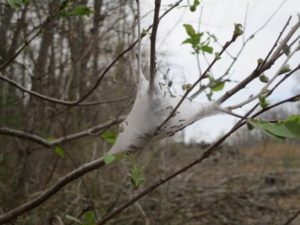
Eastern tent caterpillars on a wild cherry tree.
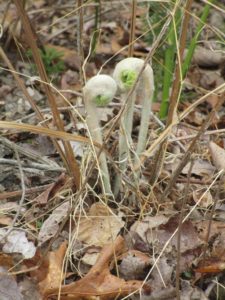
Cinnamon fern in its fiddlehead stage.
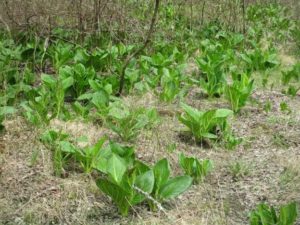
Skunk cabbage.
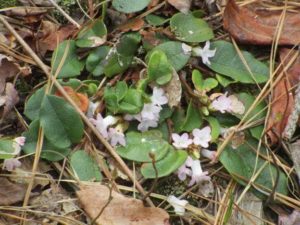
Trailing arbutus, “Epigaea repens,” – or “May pinks,” as Ma called them.
WANDERING BLACK BEARS: South Brunswick/Middlesex County, for example, had a sighting of a black bear, “Ursus americanus,” in recent days. So, just a heads up for the spring-summer roaming of bears. These wandering bears are likely to be young males, 80 to 100 pounds, chased off by older, larger males from traditional New Jersey “bear country” in the northwestern part of the state. So, the young males fan out, looking for their own territory.
CUTTING THE LAWN: I cut the lawn for the first time this season April 18 — and was aching that night.
WILD ONIONS: As I began cutting the lawn, I smelled onions – the wild ones growing in the lawn and now being mowed. I wish I liked onions more than I do, because there are plenty in my lawn.
SEEDING THE LAWN: As I maintain a no-fuss lawn and yearn for less and less lawn with more and more garden and wildlife patches, others want the magazine-looking lawn. I see these folks talking about seeding. Now is not the right time of year. Seed as early in September as possible and no later than mid-September is the advice I picked up a few years ago from the Rutgers University Cooperative Extension Service.
HOUSE PLANTS: I have about 30 house plants: devil’s ivy, spider plant, wandering Jew. On Easter Sunday, during my weekly-or-so watering, I was able to move some outside for watering, which is less messy, because it was so warm.
NIGHT SKY: Catch a look at the constellation Orion — easily identified by its belt of three stars before it disappears from view until the fall.
HUMAN-MADE OBJECTS IN SPACE: I always check out the night sky and, several days ago, I got a few-seconds view of a satellite or space junk. It was easy to pick out: moving across the sky, only a speck, not blinking. Not blinking because the light is the sun reflecting off it, rather than human lighting. So, as our sun-reflected view diminishes, the satellite disappears.
SUNRISE/SUNSET: For the week of April 23, Sunday, to April 29, Saturday, the sun will rise at about 6 a.m. to 6:10 a.m. and set at about 7:45 p.m. to 7:50 p.m.
WEATHER: Go to the National Weather Service forecasting station for the area, http://www.weather.gov/phi/.
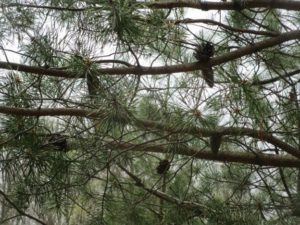
A Virginia pine, “Pinus virginiana,” in the Pine Barrens around Helmetta
Joe Sapia, 60, is a lifelong Monroe resident. He is a Pine Barrens naturalist and an organic vegetable-fruit gardener. He gardens the same backyard plot as did his Italian-American father, Joe Sr., and his Polish-immigrant, maternal grandmother, Annie Poznanski Onda. Both are inspirations for his food gardening. He draws inspiration on the local Pine Barrens from his mother, Sophie Onda Sapia, who lived her whole life in these Pines, and his Grandma Annie.

























































































